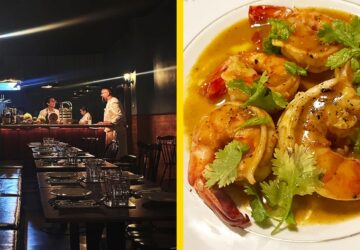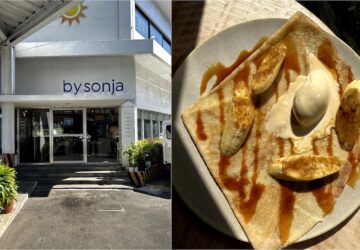Asin tibuok was once lamented as a dying culinary product. Thankfully, our present environment was ready to rescue it. People shared stories about the artisanal salt on social media, and chefs, foodies, and investors eventually designed and marketed more recipes around it, ultimately reviving demand and essentially saving it.
Similarly, many Filipino heritage food and agricultural products are under threat from various factors, as in the case of ylang-ylang flowers being trademarked by a French perfume company, competition from imported mass-produced products sold for cheap (e.g. imported jewelry), and goods intentionally mislabeled and sold as “authentic,” like Sagada coffee and oranges.
Sometimes, the factors come from within, like when younger generations of Filipinos slowly neglect homegrown food and dishes in favor of fast food.
Manila-based Itawes people tell me of a once-commonly-grown fruit-bearing tree in Cagayan that used to dot households around Tuguegarao but over the decades has largely disappeared from public consciousness. It’s telling how my informants can’t recall the name.
“The geographic indication delineates that the product name isn’t simply a brand but is the resultant work from generations of a community of producers and processors, and that the product has unique characteristics due to both human and natural factors linked to the geographical origin,” says REDD co-founder Peter Damary.
Meanwhile, colleagues who’ve done fieldwork in the Ilocos region, known as the origin of many vegetable dishes such as dineng-deng, pinakbet, and poqui poqui report that vegetable consumption has declined among younger Ilokanos as more fast food chains have sprung up around town.
More often than not, many of these problems stem from poor marketing.
Protecting food heritage
Fernando Zialcita, a professor from the Sociology and Anthropology Department in the Ateneo de Manila University believes that while market forces or rather bad actors working within the modern market economy threaten heritage products and their producers, modern market forces can also be harnessed to protect and promote heirloom goods.
Many foodies know that products like champagne, prosciutto, and Parmigiano Reggiano cheese use names that cannot be used elsewhere; thus, “sparkling wine” for libations made outside the Champagne region in France or “parmesan cheese” for curds using a similar process but not made using the traditions and materials found in the Parma region of Italy.
These heritage practices and resultant food products are protected by laws made by European Union member states and upheld via treaties among countries, stemming from the 1883 Paris Convention on Industrial Property. This is where Geographical Indications (GIs) come into play.
What are geographical indications?
REDD co-founder Peter Damary, who hails from Switzerland and is now based in Davao expounds: “The geographic indication delineates that the product name isn’t simply a brand but is the resultant work from generations of a community of producers and processors, and that the product has unique characteristics due to both human and natural factors linked to the geographical origin. The unique characteristics and special qualities are what gives the product its reputation—and said reputation provides market value for the product.” REDD is an NGO that advocates for GI protections across countries.
A 2019 booklet by the EU’s ASEAN Working Group on Intellectual Property Cooperation states that “there are already many GIs from ASEAN countries which have entered international markets and are contributing to economic development and trade in the region, such as Kampot Pepper from Cambodia, Amed Bali Salt from Indonesia, and Doi Chaang Coffee and Pineapple Huaymon from Thailand.”
Closer to home, fellow Southeast Asian nations have initiated their own GI protections. A 2019 booklet by the EU’s ASEAN Working Group on Intellectual Property Cooperation states that “there are already many GIs from ASEAN countries which have entered international markets and are contributing to economic development and trade in the region, such as Kampot Pepper from Cambodia, Amed Bali Salt from Indonesia, and Doi Chaang Coffee and Pineapple Huaymon from Thailand.”
The same booklet notes that the Philippines had yet to ratify a Geographic Indication registration system separate from regular intellectual property filing.
In terms of promotion, the Philippines also has the One Town, One Product (OTOP) program, launched in 2004, with an updated program ready for signing in 2023. It provides infrastructure, marketing, and funding to micro, small, and medium businesses in Philippine localities.
Similar to the EU’s GI programs, OTOP encourages locals to focus on heritage products using materials and processes endemic to said locales.
In 2022, the Intellectual Property Office of the Philippines (IPO) released a bulletin describing updated GI implementing rules and regulations (IRRs), an update of Republic Act 8293 or the 1997 Intellectual Property Code of the Philippines, that also created a unique, separate GI-specific intellectual property filing system handled by the Bureau of Trademarks (BOT), all adjusted to textile, agricultural, and similar products defined by regional origin and traditional process. The IRRs also cite the 1883 Paris Convention.
What’s notable is that businesses cannot use “expressions such as ‘kind,’ ‘type,’ or ‘style,’” when describing similar goods that however do not come from the actual geographic origin, and hopefully, that means consumers get real Sagada coffee, Guimaras mangoes, or Ilokano jewelry. “A GI,” Damary explains, “is supposed to bring more transparency to the market.”
“While laws and enforcement exist, ultimately, the best protector of heritage food products against bad actors is collective citizen and community action.”
Furthermore, the 2022 IRRs also expand the protections to Indigenous Peoples and their heritage products. Finally, unlike trademarks, which are filed by solo entrepreneurs or companies, GIs are filed by producers’ associations or their authorized representatives.
Such a development further strengthens what Damary believes is the “exclusive right of the legitimate producers to use the Indication (name) for the good in question.”
The IPO is also hoping that Congress passes an expanded GI bill. Currently, the 2022 IRRs focus on streamlined registration but not so much on GI legal protection and penalties for bad actors.
Communities are pillars in cultural heritage preservation
However, the presence of a law does not necessarily imply its implementation or enforcement. Sometimes, this can be chalked up to authorities’ strained resources. In the case of the new GI rules, most of the work of investigating, verifying, and approving, updating, or denying applications rests with the BOT Director, and this may result in backlogs.
This is where “community governance” as described by Damary comes into play. “While laws and enforcement exist, ultimately, the best protector of heritage food products against bad actors is collective citizen and community action.” The healthiest, most equitable democracy after all, stems from citizen involvement, a never-ending vigil that may die in darkness but is sustained by awareness and action.
Furthermore, valid criticisms about GIs as a practice note how modern market forces are harming heritage businesses yet are harnessed here in an attempt to protect culture. Is this but a palliative solution that ultimately affirms the current dominance of consumer capitalism?
Perhaps. And perhaps a better future starts with the best practices of today.
Citing the case of how feta cheese producers and goat farmers from Greece were protected from Danish businessmen using industrial-farmed cows’ milk to make imitation Feta, Damary believes that GIs are the best present solution in that they “de-commodified” feta cheese and “stopped the original product and the Greek goatherds and artisans involved in its production from disappearing and losing their livelihoods. It helped them stay in the market. The Danish can continue to produce fresh salty cheese, but under a different name.”





